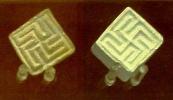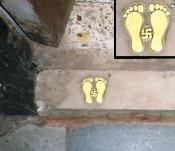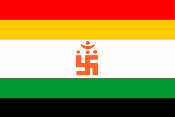Swastika – A Western World Taboo but Eastern World Good Luck Symbol
By Cozee Cackel
|
For any of us here in North America the swastika is virtually a taboo symbol and one that evokes fear and fright in the hearts of many. However, before it got its bad reputation as the official emblem of the Nazi Party it became strongly associated with its iconic usage by Nazi Germany, and it has hence become stigmatized in the Western world.
Notably the swastika has been outlawed in Germany if used as a symbol of Nazism. Many modern political extremists and Neo-Nazi groups such as Afrikaner Weerstandsbeweging and Russian National Unity use stylized swastikas or similar symbols.
The swastika, however, remains widely used in Eastern religions, specifically in Hinduism, Buddhism and Jainism. Archaeological evidence of swastika-shaped ornaments dates from the Neolithic period and throughout the Iron Age and Classical Antiquity so use of this symbol is thousands of years old.
The word swastika is derived from the Sanskrit word svastika, meaning any lucky or auspicious object, and in particular, a mark made on persons and things to denote good luck. It is composed of su- meaning “good, well” and asti “to be” svasti thus means “well-being.” Svastika might thus be translated literally as “that which is associated with well-being,” corresponding to “lucky charm” or “thing that is auspicious.” The Sanskrit term has been in use in English since 1871.
Native American Traditions
The swastika shape was used by some Native Americans. It has been found in excavations of Mississippian-era sites in the Ohio and Mississippi River valleys. It is frequently used as a motif on objects associated with the Southeastern Ceremonial Complex (S.E.C.C.). It was also widely used by many southwestern tribes, most notably the Navajo. Among various tribes, the swastika carried different meanings. To the Hopi it represented the wandering Hopi clan; to the Navajo it was one symbol for a whirling log, a sacred image representing a legend that was used in healing rituals (after learning of the Nazi association, the Navajo discontinued use of the symbol). A brightly colored First Nations saddle featuring swastika designs is on display at the Royal Saskatchewan Museum in Canada.
Historical Use in the East
The swastika is a historical sacred symbol in Indian religions.It rose to importance in Buddhism during the Mauryan Empire and in Hinduism with the decline of Buddhism in India during the Gupta Empire. With the spread of Buddhism, the Buddhist swastika reached Tibet and China. The symbol was also introduced to Balinese Hinduism by Hindu kings. The use of the swastika by the Bön faith of Tibet, as well as later syncretic religions, such as Cao Dai of Vietnam and Falun Gong of China, can also be traced to Buddhist influence. Jainism gives even more prominence to the swastika than does Hinduism. It is a symbol of the seventh Jina (Saint). It is considered to be one of the 24 auspicious marks and the emblem of the seventh arhat of the present age. All Jain temples and holy books must contain the swastika and ceremonies typically begin and end with creating a swastika mark several times with rice around the altar.
Some Asian Traditions
Some sources indicate that the Chinese Empress Wu (684-704) of the Tang Dynasty decreed that the swastika would be used as an alternative symbol of the Sun.
The Mandarin “wan” is a homophone for the number 10,000 and is commonly used to represent the whole of Creation, e.g. ‘the myriad things’ in the Dao De Jing.
In Japan, the swastika is called manji. Since the Middle Ages, it has been used as a coat of arms by various Japanese families. On Japanese maps, a swastika (left-facing and horizontal) is used to mark the location of a Buddhist temple.
In Chinese and Japanese art, the swastika is often found as part of a repeating pattern. One common pattern, called sayagata in Japanese, comprises left- and right-facing swastikas joined by lines.
Western Historical use
In Bronze Age Europe, the “Sun cross” (a cross in a circle) appears frequently, often interpreted as a solar symbol. Swastika shapes have been found on numerous artifacts from Iron Age Europe. This prehistoric use seems to be reflected in the appearance of the symbol in various folk cultures of Europe.
Contemporary use in Asia
South Asia

Jain swastika
East Asia
Japanese maps continue to use the swastika symbol to denote a Buddhist temple.
In Korea, maps also use the swastika symbol to denote a temple. The swastika is also a very common sight at both rural and urban Buddhist Temples.
Central Asia
In 2005, authorities in Tajikistan called for the widespread adoption of the swastika as a national symbol. President Emomali Rahmonov declared the swastika an Aryan symbol and 2006 to be “the year of Aryan culture,” which would be a time to “study and popularize Aryan contributions to the history of the world civilization, raise a new generation (of Tajiks) with the spirit of national self-determination, and develop deeper ties with other ethnicities and cultures.”
On Seeing a Swastika
It’s a rather rare sight here in the USA to see a swastika. When we do it is generally from one of the extremist or race hatred groups. However if you travel to some other parts of the world it could be a rather common site. Know that there is a long, very long history behind this easy to recognize symbol in all its forms and designs.
Its unfortunate such a bad connotation has been bestowed upon the swastika which is a Western World taboo, but Eastern World Good Luck symbol in many parts of the world.
* Parts of this document were taken from Wikipedia, the free encyclopedia

beginners -read these reports- learn about internet marketing
Questions on the Swastika

Lizzie asks…
Why is the Swastika so “bad”?
I really like the Swastika symbol. It really stands for Peace, and Good Luck. I believe in that stuff, but I’m NOT a Nazi sympathizer. I just don’t understand why people hate it so much. It’s just a useless, pointless symbol.
I’m not a Nazi or anything, I just think the symbol looks cool. =-P

Suzi Q answers:
As you probably know the swastika dates back to the neolithic period and as you say denotes good luck, peace etc. Nowadays the majority of the people are unaware of the origins of the swastika, and immediately associate it with the nazis and also newer racist groups.
So sorry that a symbol denoting so much good must now be associated with so much bad.
Question powered by Yahoo! Answers
More on Swastika
Swastika Pyramid
Questions About the Swastika
Read More
Superstitions
Lucky Symbols
50 Luck Quotes
Feng Shui










Hi that is a very fascinating view, It does give one food for thought, I am very delighted I stumbled on your blog, i was using Stumbleupon at the time, anyway i don’t want to drift on too much, but i would like to mention that I will be back when I have a little time to read your blog more exhaustively, Once again thanks for the post and please do keep up the good work,